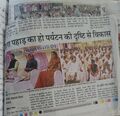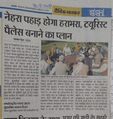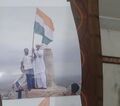Nehra Pahad
| Author:Laxman Burdak, IFS (R) |
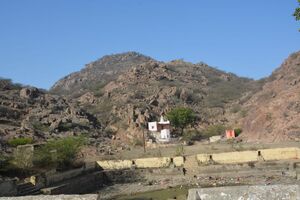
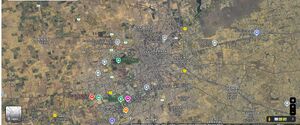
Nehra Pahad (नेहरा पहाड़) or Nehra Hill is an ancient historical mountain in Jhunjhunu city of Rajasthan, India.
There is one more Naro Hill near ancient archaeological site Bharhut in Satna district of Madhya Pradesh.
Origin
It gets name from Nehra clan.
Variants
- Nehara Pahad (नेहरा पहाड़)
- Nehara Pahar (नेहरा पहाड़)
- Nehra Pahar (नेहरा पहाड़)
- Naira Pahar (नैरा पहाड़)
- Naira Pahad (नैरा पहाड़)
- Nehra Hill
- Nehra mountain
- Naiarachala (नैराचल)
- Naharachala (नहराचल) : The antiquity of name Nehra Pahar, Jhunjhunu is proved by epigraphical evidences. The Sundha hill Inscription of Chachigadeva Chauhan of year S.V. 1319 (1262 AD) mentions this place in verse-50 as Naharachala (नहराचल) i.e. the Nehra mountain. [1] See Sunda hill Inscription of Chachigadeva
- Naharachala Parvata (नहराचल पर्वत): भारत के प्राचीन राजवंश, भाग-1,p.307 पर वर्णित [2]
Location
Nehra Hill is located in the west of Jhunjhunu town. Hill is a 1684 feet above see-level and visible from miles around.
In Nehra History
Thakur Deshraj[3] writes that Nehra Jats ruled in Rajasthan over an area of 200 sqaire miles. In fifteenth century Nehras ruled at Narhar in Jhunjhunu district. At Naharpur, 16 miles down below the Nehra Hill, their another group ruled. At the end of 16th century and beginning of 17th century there was a war between Nehras and Muslim rulers. The Nehra chieftain Jhunjha or Jujhar Singh won the war and captured Jhunjhunu town. Later at the time of victory ceremony he was deceived by Shekhawat Rajputs and killed. Jhunjhunu town in Rajasthan was established in the memory of Jujhar Singh Nehra, the above Jat chieftain. There were 1760 villages under the rule of Nehras in Rajasthan.
About Narhar, Thakur Deshraj[4] writes that it was ruled by Nehra Jats. Nehra jats ruled in Rajasthan over an area of 200 square miles. The Nehra hills of Rajasthan were their territory. To the west of Jhunjhunu town is a Hill 1684 feet above see-level and visible from miles around. [5]. This hill near Jhunjhunu town is still known as Nehra Hill in their memory. Another hill was known as Maura which was famous in memory of Mauryas. Nehra in Jaipur was the first capital in olden times. In the fifteenth century Nehras ruled at Narhar, where they had a fort. At Naharpur, 16 miles down below the Nehra Hill, there another group ruled. The present Shekhawati at that time was known as Nehrawati. [6]
At the end of 16th century and beginning of 17th century there was a war between Nehras and Muslim rulers. When Nehras were defeated by nawabs, they used to offer gifts to the Nawabs on special occasions, due to this they were also called 'Shahi bhentwal'.
In Chauhan records
The Sundha hill Inscription of Chachigadeva (Bhinmal, Jalore) V. 1319 (1262 AD) mentions the Salya (Syal), the Sangas, and the Nahras. [7] [8]
Dasharatha Sharma in "Early Chauhan Dynasties" [Page-176] writes about Jalor Chauhan ruler - Chachigadeva. ....We have eight inscriptions for Chachigadeva, the son and successor of Udayasimha. These range from V. 1319 to V.1333. The earliest is the Sundha Inscription of V. 1319 edited by Dr. Kielhorn in Epigraphia Indica, IX. pp. 74ff. Some three years earlier however than the earliest of these (which belongs to V. 1319) is the record of a pratishtha at Jalor, dated the 6th of the bright half of Magha V. 1316. It states that Padru and Muliga put a gold cupola and gold dhvaja on the temple of Shantinatha at Suvarnagiri in the reign of Chachigadeva (Kharataragachchhapattavali. p. 51).
- "Hating his enemies as thorns" states the Sundha Inscription "he destroyed the roaring Gurjara lord Virama," enjoyed the fall of the tremulous (or leaping) Patuka, deprived Sanga of his colour and acted as a thunderbolt for the mountain, the furious Nahara".
|
| Sundha hill Inscription of Chachigadeva of V.S.1319 (A.D. 1262) (Verse-50) [9] |
Dasharatha Sharma[10] writes that The "furious Nahara" of the inscription, again, is equally unidentifiable. But we know from Jat history above that नहराचल means Nehra Mountain. There is a mountain in Jhunjhunu called Nehra Pahad which in Sanskrit is called नहराचल. Thus Nehras were rulers in Vikram Samvat 1319 (1262 AD).
Naro Hill in Satna district Madhya Pradesh
We find mention of Naro Hill and fort in the history of Parihars of Nagod. Nagod is a town and tahsil in Satna district in the Madhya Pradesh. It is located 17 miles from the town of Satna, Madhya Pradesh. Nagod derives its name from Naga + vadha, means massacre of Naga people. The state was earlier occupied and ruled by Nagas.
The chiefs of Nagod are Parihars, one of the four Agnikula clans, whose traditional home is on Mount Abu. The history of their migration into Bundelkhand and Baghelkhand is of considerable interest, but exceedingly difficult to unravel. In the seventh century the Gaharwars held Bundelkhand, but were driven out or at least subordinated by an incursion of Parihars from the west, who established themselves in the country lying between Mahoba and Mau (near Chhatarpur), and rapidly extended their sway over most of this region. In the ninth century they in their turn became subordinate to the great Chandel clan; and, though not exterminated, a large section was obliged to migrate still farther eastwards into Baghelkhand, where, according to their annals, Raja Dhara Singh seized the fort of Naro from the Teli Rajas in 1344.
नेहरा पहाड़ की प्राचीनता
- 79: ठाकुर देशराज ने लिखा है कि नेहरा गोत्र की उत्पत्ति वैवस्वत मनु के पुत्र नरिष्यंत (नरहरी) से मानी जाती है. पहले ये पाकिस्तान के सिंध प्रान्त में नेहरा पर्वत पर निवास करते थे. मैगस्थनीज़ (350BC- 290BC) और प्लिनी (23–79 AD) ने इनको नरेई लिखा है, जो कि नेहरा के नाम से प्रसिद्ध हैं, कैपटेलिया नाम से घिरी हुई जगह में उनका स्थान बताया गया है. वहां से चल कर राजस्थान के जांगलदेश भू-भाग में बसे और झुंझुनू में नेहरा पहाड़ पर आकर निवास करने लगे. राजस्थान में नेहरा जाटों का तकरीबन 200 वर्ग मील भूमि पर किसी समय शासन रहा था. उनके ही नाम पर झुंझुनू के निकट पर्वत आज भी नेहरा पहाड़ कहलाता है. दूसरा पहाड़ जो मौरा (मौड़ा) है, मौर्य लोगों के नाम से मशहूर है. नेहरा लोगों में सरदार झुन्झा अथवा जुझार सिंह बड़े मशहूर योद्धा हुए हैं. उनके नाम से झूंझनूं जैसा प्रसिद्ध नगर विख्यात है. [11]
- दलीप सिंह अहलावत[12] लिखते हैं: सूर्यवंशी वैवस्वत मनु के इक्ष्वाकु, नरिष्यन्त (उपनाम नरहरि) आदि कई पुत्र हुए। नरहरि की सन्तान सिंध में नेहरा पर्वत के समीपवर्ती प्रदेश के अधिकारी होने से नेहरा नाम से प्रसिद्ध हुई। इस तरह से नेहरा जाटवंश प्रचलित हुआ। जयपुर की वर्तमान शेखावाटी के प्राचीन शासक नेहरा जाट थे जिन्होंने सिंध से आकर नरहड़ में किला बनाकर दो सौ वर्ग मील भूमि पर अधिकार स्थिर कर लिया था। यहां से 15 मील पर इन्होंने नाहरपुर बसाया। उनके नाम से झुंझनूं के निकट का पहाड़ आज भी नेहरा पहाड़ कहलाता है। दूसरे पहाड़ का नाम मौड़ा (मौरा) है जो मौर्य जाटों के नाम पर प्रसिद्ध है। मुगल शासन आने से पूर्व शेखावत राजपूतों ने नेहरा जाटों को पराजित कर दिया और इनका राज्य छीन लिया। नेहरा जाटों की यह नेहरावाटी[13] आवासभूमि शेखावतों के विजयी होते ही शेखावाटी के नाम पर प्रसिद्ध हो गई।
- 7वीं सदी: नेहरा पहाड़ नाम पीढ़ी-दर-पीढ़ी चला आ रहा है. इसके लिए किसी ने बोर्ड नहीं लगाया था. इससे जाहिर है कि झूंझा नेहरा गोत्र का था. झुंझुनू में 'नू' शब्द आता है जो गुजराती से सम्बन्ध रखता है. गुर्जर काल में स्वाभाविक रूप से इस क्षेत्र पर गुजराती का प्रभाव रहा है. जैन संस्कृति और जैन मुनि भी गुजरात से आते थे. इससे प्रकट है कि झुंझुनू छठी-सातवीं सदी में बस गया था. हमारे यहां नू शब्द के बहुत कम गांव या शहर हैं जैसे लाडनूं आदि. यह शब्द प्राचीनता को प्रकट करता है. [14]
- 1262 : The antiquity of name Jhunjhunu is proved by epigraphical evidences. The Sundha inscription of Chachigadeva Chauhan of year S.V. 1319 (1262 AD) mentions this place as Naharachala (नहराचल) i.e. the Nehra mountain. [15]
- 1262 : Bhim Singh Dahiya tells that the Sundha hill Inscription of Chachigadeva (Bhinmal, Jalore) V. 1319 (1262 AD) mentions the Salya (Syal), the Sangas, and the Nahras. [16] [17]
नेहरा पहाड़ का साहित्य
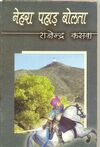
- नेहरा पहाड़ बोलता (शेखावाटी अंचल पर आधारित ऐतिहासिक उपन्यास)
- लेखक:राजेन्द्र कसवा, Mob-9414668488
- प्रकाशक:मानव कल्याण संस्था, बी-४, मान नगर, झुंझुनू (राजस्थान),
- प्रथम संस्करण २००६, मूल्य रु. २५०/-
नेहरा पहाड़ पर मनाया आजादी का 78वां जश्न:15.08.2024
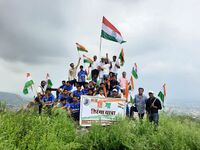
नेहरा पहाड़ पर करीब 36 से अधिक युवाओं ने चढ़कर तिरंगा लहराया। 82 साल के बुजुर्ग और रिटायर्ड कैप्टन मोहनलाल भी जिले की सबसे ऊंची चोटी नेहरा पहाड़ पर युवाओं के साथ चढे़।
झुंझुनू में देश की आजादी का 78वां जश्न पहाड़ की सबसे ऊंची चोटी पर मनाया गया। गुरुवार 15.08.2024 को जिले की सबसे ऊंची चोटी नेहरा पहाड़ पर युवाओं के साथ-साथ बुजुर्ग और रिटायर्ड कैप्टन मोहनलाल भी चढ़े और तिरंगा फहराया।
झुंझुनू जिले में स्वतंत्रता दिवस का जोश युवाओं के साथ-साथ बुजुर्गों में भी दिखाई दिया। 82 साल के बुजुर्ग और रिटायर्ड कैप्टन मोहनलाल भी जिले की सबसे ऊंची चोटी नेहरा पहाड़ पर युवाओं के साथ चढे़ और तिरंगा फहराया। नेहरा पहाड़ पर करीब 36 से अधिक युवाओं ने चढ़कर तिरंगा लहराया। इनमें पूर्व सैनिक भी शामिल रहे।
भारत माता के जयघोष और देशभक्ति गीतों पर उत्साह से तिरंगा यात्रा 4 किमी की दूरी तय कर नेहरा पहाड़ की तलहटी में स्थित समस तालाब तक निकाली गई। इसके उपरांत विशाल तिरंगे के साथ जिले की सबसे ऊंची चोटी पर चढ़कर युवाओं ने तिरंगा फहराया।
इस अवसर पर संस्था के पूर्व अध्यक्ष बजरंग लाल नेहरा, उप वन संरक्षक बीएल नेहरा, कोषाध्यक्ष महेंद्र चौधरी, बाबूलाल थालौर, दलीप चनाना, इंद्राज, सुमेर झाझड़िया, विजय गोपाल मोटसरा, पार्षद प्रमोद जानूं आदि मौजूद थे।
स्रोत: अर्पित याज्ञनिक, अमर उजाला, झुंझुनू, 15 Aug 2024
नेहरा पहाड़ का दर्द जानने आई टीम, अतिक्रमण मुक्त कर पर्यटन स्थल के रूप में विकसित करने पर जोर
हरियाणा सरकार में तीन बार कैबिनेट मंत्री रहे और नेहरा खाप के राष्ट्रीय अध्यक्ष जगदीश नेहरा ने केंद्र और राज्य सरकार से मांग की है कि झुंझुनूं स्थित नेहरा पहाड़ को अतिक्रमण से मुक्त कराया जाए और इसे पर्यटन स्थल के रूप में विकसित किया जाए। पूर्व मंत्री नेहरा ने वीरवर झुझार सिंह संस्थान और नेहरा खाप के पदाधिकारियों के प्रतिनिधि मंडल के साथ दौरा करके नेहरा पहाड़ का दर्द जाना और वर्तमान स्थिति का जायजा लिया। नेहरा पहाड़ का दौरा करने के बाद इस प्रतिनिधि मंडल ने झुंझुनूं के सर्किट हाउस में इसे लेकर विचार-विमर्श किया।
जगदीश नेहरा ने कहा कि नेहरा पहाड़ झुंझुनूं शहर की शान है, लेकिन अतिक्रमण इस शान को बर्बाद कर रहा है। नेहरा पहाड़ की जमीन पर कब्जे हो रहे हैं और क्रेशर माफिया पहाड़ को चट करने में जुटा है। नेहरा ने कहा है कि सरकार यहां से अतिक्रमण को तुरंत हटाए और नेहरा पहाड़ को पर्यटन स्थल के रूप में विकसित करे। उन्होंने कहा कि जल्द ही वे नेहरा पहाड़ के जीर्णोद्धार के लिए केंद्र सरकार से मिल कर इसे बचाने का प्रयास करेंगे।
उल्लेखनीय है कि झुंझुनूं के साहित्यकर राजेन्द्र कस्वां ने भी नेहरा पहाड़ पर पूरी पुस्तक लिखी है। इस अवसर पर वीरवर झुझार सिंह संस्थान के अध्यक्ष बजरंग लाल नेहरा और सचिव भीवांराम चौधरी ने कहा कि संस्थान इस बारे में सरकार को हरसंभव मदद देने के लिए तैयार है। उन्होंने कहा कि नेहरा पहाड़ का अस्तित्व खतरे में है। नेहरा पहाड़ के साथ झुंझुनूं के संस्थापक वीरवर झुझार सिंह की अटूट यादें जुड़ी हैं। यह आस्था का विषय भी है।
प्रतिनिधि मंडल में शामिल एनसीआर मीडिया क्लब के अध्यक्ष अमित नेहरा ने कहा कि नेहरा पहाड़ पर अवैध निर्माण और अवैध खनन बन्द नहीं हुआ तो आने वाली पीढ़ियां हमें कभी माफ नहीं करेंगी। हमें पूरी ताकत लगा कर नेहरा पहाड़ को बचाना होगा। नेहरा खाप राजस्थान के अध्यक्ष बलवीर सिंह नेहरा ने कहा कि इस बारे में कई बार सरकार को चेताया जा चुका है। उम्मीद है कि सरकार जल्द ही नेहरा पहाड़ के अस्तित्व को बचाने के लिए सार्थक प्रयास करेगी। उन्होंने बताया कि कुछ समय पहले नेहरा पहाड़ के सौंदर्यीकरण के लिए सरकार ने जो योजना बनाई थी, उसे भी मूर्त रूप दिया जाना चाहिए। प्रतिनिधि मंडल में शिवकरण नेहरा, महेंद्र सिंह नेहरा, कैप्टन विद्याधर नेहरा, सहीराम, कैप्टन मोहनलाल समेत नेहरा समाज के अनेक गणमान्य व्यक्ति मौजूद थे।
Source : भास्कर संवाददाता, झुंझुनूं, वर्ष 2019
नेहरा पहाड़ के इतिहास पर तथ्य
नेहरा पहाड़ या नेहरा हिल झुंझुनू में स्थित एक पर्वत है. इसका नाम नेहरा वंश के नाम पर पड़ा है। नेहरा पहाड़ झुंझुनू शहर के पश्चिम में स्थित है. यह पहाड़ी समुद्र तल से 1684 फीट ऊंची है और आसपास मीलों दूर से दिखाई देती है.
ठाकुर देशराज ने लिखा है कि नेहरा गोत्र की उत्पत्ति वैवस्वत मनु के पुत्र नरिष्यंत (नरहरी) से मानी जाती है. पहले ये पाकिस्तान के सिंध प्रान्त में नेहरा पर्वत पर निवास करते थे. मैगस्थनीज़ (350BC- 290BC) और प्लिनी (23–79 AD) ने इनको नरेई लिखा है, जो कि नेहरा के नाम से प्रसिद्ध हैं, कैपिटेलिया नाम के पर्वत से घिरी हुई जगह में उनका स्थान बताया गया है. वहां से चल कर राजस्थान के जांगलदेश भू-भाग में बसे और झुंझुनू में नेहरा पहाड़ पर आकर निवास करने लगे. राजस्थान में नेहरा जाटों का तकरीबन 200 वर्ग मील भूमि पर किसी समय शासन रहा था. उनके ही नाम पर झुंझुनू के निकट पर्वत आज भी नेहरा पहाड़ कहलाता है. दूसरा पहाड़ जो मौरा (मौड़ा) है, मौर्य लोगों के नाम से मशहूर है. नेहरा लोगों में सरदार झुन्झा अथवा जुझार सिंह बड़े मशहूर योद्धा हुए हैं. उनके नाम से झूंझनूं जैसा प्रसिद्ध नगर विख्यात है. [18]
दलीप सिंह अहलावत[19] ने लिखा है कि मुगल शासन आने से पूर्व शेखावत राजपूतों ने नेहरा जाटों को पराजित कर दिया और इनका राज्य छीन लिया। नेहरा जाटों की यह आवासभूमि नेहरावाटी कहलाती थी। [20] शेखावतों के विजयी होने पर यह क्षेत्र शेखावाटी के नाम पर प्रसिद्ध हो गया।
नेहरा पहाड़ का नामकरण कब हुआ यह अनुसंधान का विषय है. परन्तु इतिहासकार 6-7 वीं सदी में नेहरा लोगों के इधर आने का और नेहरा पहाड़ नामकरण करने का अनुमान लगाते हैं.
|
| Sundha hill Inscription of Chachigadeva of V.S.1319 (A.D. 1262) (Verse-50) [21] |
नेहरा पहाड़ की प्राचीनता प्रमाणित करने वाले पुरातात्विक अभिलेख उपलब्ध हैं. जालोर के सोनगरा चौहान राजा चाचिगदेव के सूंधा पहाड़ी के संवत 1319 (1262 ई.) के लेख (श्लोक-50) में नहराचल अर्थात नेहरा पर्वत का उल्लेख किया गया है. [22] देखो Sundha hill Inscription of Chachigadeva
भारत के प्राचीन राजवंश, भाग-1, p.307 के अनुसार चाचिगदेव उदयसिंहका बड़ा पुत्र और उत्तराधिकारी था । सूंधा पहाड़ी के लेख में इसे गुजरात के राजा वीरमको मारनेवाला, शत्रुशल्यको नीचा दिखाने वाला, पातुक और संग नामक पुरुषोंको हरानेवाला और नहराचल पर्वत के लिये वज्र समान लिखा है। [23]
नेहरा पहाड़ का इतिहास
लेखक : लक्ष्मण राम बुरडक IFS (R) - सेवा निवृत अपर प्रधान मुख्य वन संरक्षक, मध्यप्रदेश
नेहरा पहाड़ झुंझुनू में स्थित एक पर्वत है. नेहरा पहाड़ झुंझुनू शहर के पश्चिम में स्थित है. यह पहाड़ समुद्र तल से 1684 फीट ऊंचा है और आसपास मीलों दूर से दिखाई देता है. यह पहाड़ झुंझुनू शहर की शान और पहचान है. नेहरा पहाड़ को कई अन्य नामों से भी जाना जाता है जैसे - नैरा पहाड़, नहरा पर्वत, नहराचल, नहराचल पर्वत आदि.
नेहरा पहाड़ का नामकरण
नेहरा पहाड़ का नामकरण ‘नेहरा वंश’ के नाम पर पड़ा है. नेहरा पहाड़ का इतिहास नेहरा वंश के इतिहास से जुडा हुआ है इसलिए यहाँ नेहरा वंश का संक्षिप्त इतिहास जानना उचित होगा. ठाकुर देशराज ने लिखा है कि नेहरा गोत्र की उत्पत्ति वैवस्वत मनु के पुत्र नरिष्यंत (नरहरी) से मानी जाती है. पहले ये पाकिस्तान के सिंध प्रान्त में नेहरा पर्वत पर निवास करते थे. मैगस्थनीज़ (350BC- 290BC) और प्लिनी (23–79 AD) ने इनको नरेई लिखा है, जो कि नेहरा के नाम से प्रसिद्ध हैं, कैपिटेलिया नाम के पर्वत से घिरी हुई जगह में उनका स्थान बताया गया है. वहां से चल कर राजस्थान के जांगलदेश भू-भाग में झुंझुनू के नेहरा पहाड़ पर आकर निवास करने लगे. प्राचीन काल में यह परम्परा रही है कि कोई जन-समूह विस्थापित होकर नई जगह जाता था तो नई जगह का नामकरण भी पुरानी जगह के नाम पर ही रखते थे. इसके पास ही झुंझुनू में एक दूसरा पहाड़ है जिसका नाम ‘मोरा पहाड़’ है जिसका नामकरण संभवत: मौर्य शासकों के नाम पर पड़ा. मैगस्थनीज़ ने अपने वर्णन में भी Moruni (Mor) के पास ही Narae (Nehra) का उल्लेख किया है. मौरा (मौड़ा) और नेहरा पहाड़ का एक साथ होना ऐतिहासिक तथ्यों की पुष्टि करता है. संभवत: 'नेहरा वंश' मगध के 'मौर्य साम्राज्य' (321BC-185BC) का अभिन्न अंग रहा है. मगध (बिहार) में 'र' को 'ड़' उच्चारित किया जाता है. इसलिए 'मौरा पहाड़' को हिंदी में 'मौड़ा पहाड़' बोला जाने लगा.
राजस्थान में नेहरा जाटों का शासन
राजस्थान में नेहरा जाटों का तकरीबन 200 वर्ग मील भूमि पर किसी समय शासन रहा था. उनके ही नाम पर झुंझुनू के निकट पर्वत आज भी नेहरा पहाड़ कहलाता है. दूसरा पहाड़ जो मौरा (मौड़ा) है, मौर्य लोगों के नाम से मशहूर है. नेहरा लोगों में सरदार झुन्झा अथवा जुझार सिंह बड़े मशहूर योद्धा हुए हैं. उनके नाम से झूंझनूं जैसा प्रसिद्ध नगर विख्यात है (ठाकुर देशराज, जाट इतिहास, पृ. 143).
जयपुर स्टेट की वर्तमान शेखावाटी भूभाग के प्राचीन शासक नेहरा जाट थे जिन्होंने सिंध से आकर नरहड़ में किला बनाकर दो सौ वर्ग मील भूमि पर अधिकार कर लिया था. यहां से 15 मील पर इन्होंने नाहरपुर बसाया. उनके नाम से झुंझनूं के निकट का पहाड़ आज भी नेहरा पहाड़ कहलाता है. दूसरे पहाड़ का नाम मौड़ा (मौरा) है जो मौर्य जाटों के नाम पर प्रसिद्ध है. मुगल शासन आने से पूर्व शेखावत राजपूतों ने नेहरा जाटों को पराजित कर दिया और इनका राज्य छीन लिया. नेहरा जाटों की यह आवासभूमि नेहरावाटी कहलाती थी. शेखावतों के विजयी होने पर यह क्षेत्र शेखावाटी के नाम पर प्रसिद्ध हो गया (जाट वीरों का इतिहास: दलीप सिंह अहलावत, पृष्ठ.225-226, आधुनिक जाट इतिहास, p.261).
नेहरा पहाड़ का नामकरण कब हुआ यह अनुसंधान का विषय है. परन्तु इतिहासकार 6-7 वीं सदी में नेहरा लोगों के इधर आने का और नेहरा पहाड़ नामकरण करने का अनुमान लगाते हैं.
नेहरा पहाड़ की प्राचीनता प्रमाणित करने वाले पुरातात्विक अभिलेख उपलब्ध हैं. जालोर के सोनगरा चौहान राजा चाचिगदेव के सूंधा पहाड़ी के संवत 1319 (1262 ई.) के अभिलेख (श्लोक-50) में नहराचल अर्थात नहरा पर्वत का उल्लेख किया गया है (Epigraphia Indica, Vol. IX, p. 74 ff, Dasharatha Sharma: "Early Chauhan Dynasties", p.176).
- स्फूर्जद्-वीरम-गूर्जरेश-दलनो य: शत्रु-शल्यं द्विषंश्-चञ्चत-पातुक-पातनैकरसिक: संगस्य रंगापह: उन्माद्दन्-नहराचलस्य कुलिशाकर....(चाचिगदेव का सूंधा पहाड़ी अभिलेख संवत 1319 = 1262 ई., श्लोक-50)
भारत के प्राचीन राजवंश, भाग-1 (विश्वेश्वरनाथ रेऊ, जसवंत कालेज, हिन्दीग्रंथरत्न कार्यालय, पृ.307) के अनुसार चाचिगदेव उदयसिंह का बड़ा पुत्र और उत्तराधिकारी था. सूंधा पहाड़ी के लेख में इसे गुजरात के राजा वीरम को मारनेवाला, शत्रुशल्य को नीचा दिखाने वाला, पातुक और संग नामक पुरुषों को हरानेवाला और नहराचल पर्वत के लिये वज्र समान लिखा है.
नैरो पहाड़, भरहुत, सतना, मध्य प्रदेश
नेहरा वंश के नाम पर एक अन्य पहाड़ - 'नैरो पहाड़' खोजने का अवसर लेखक को वर्ष 2006 में मिला जब आयुक्त के रूप में बाण सागर परियोजना के डूब में आने वाले ऐतिहासिक धरोहरों को संरक्षित करने का काम किया जा रहा था. मध्य प्रदेश के सतना जिले में भरहुत एक प्राचीन ऐतिहासिक स्थान है. भरहुत पहाड़ के पास ही एक और पहाड़ है जिसका नाम नैरो पहाड़ है. बौद्ध-काल में भरहुत दक्षिणपथ पर स्थित एक प्रमुख व्यापार केंद्र था. भरहुत द्वितीय-प्रथम शताब्दी ईसा पूर्व में निर्मित बौद्ध स्तूप तथा तोरणों के लिए साँची के समान ही प्रसिद्ध है.
भरहुत भारत के मध्य प्रदेश राज्य में सतना जिले में स्थित है जो अपने प्राचीन बौद्ध स्तूप, कलाकृतियों एवं अन्य पुरातात्विक वस्तुओं के लिए प्रसिद्ध है. यहाँ एक बौद्ध स्तूप के भग्नावशेष प्राप्त हुए हैं जिसका निर्माण सम्राट अशोक मौर्य के काल में हुआ था. पुरातत्वविद अलेक्जैंडर कनिंघम ने सर्वप्रथम 1873 ई. में इस स्थल का पता लगाया था. यहाँ से प्राप्त पुरातात्विक महत्व की कुछ वस्तुओं को कोलकाता के भारतीय संग्रहालय में तथा कुछ अन्य को प्रयागराज के संग्रहालय में रखा गया है. (वि.कु.माथुर, ऐतिहासिक स्थानावाली, पृ. 666)
भरहुत के लाल पहाड़ के ऊपरी चोटी से बलालदेव का 14वीं सदी का प्रारंभिक देवनागरी में लेख मिला है जिससे यह सिद्ध होता है कि इसका महत्त्व 14वीं शदी तक था. भरहुत का स्तूप अपने समय के समाज का दर्पण कहा जा सकता है. वर्तमान में भरहुत उजड़ चुका है. भरहुत के लाल पहाड़ के पास ही एक दूसरा पहाड़ है जिसका नाम ‘नैरो पहाड़’ है. ‘नैरो पहाड़’ के नाम से प्रमाण मिलता है कि नेहरावंश और मौर्यवंश के लोगों का सिंध से अभिगमन साथ-साथ हुआ है. ये तथ्य नेहरा पहाड़ की काल गणना में सहायक हो सकते हैं.
साहित्य में नेहरा पहाड़
झुंझुनूं शहर के बसने और नेहरा पहाड़ को जन-मानस में प्रसिद्धि साहित्यकार राजेंद्र कसवा ने दिलवाई. उन्होंने ‘नेहरा पहाड़ बोलता (शेखावाटी अंचल पर आधारित ऐतिहासिक उपन्यास)’ 2006 में लिखा. उनकी पुस्तक ‘नेहरा पहाड़ का सच’ 2018 में प्रकाशित हुई. ‘झुन्झुनूं के संस्थापाक झूंझा जाट' का प्रकाशन 2024 में हुआ. समय-समय पर उनके द्वारा नेहरा पहाड़ के बारे में समाचार पत्रों में लेख प्रकाशित किये.
प्रसिद्ध कवि, लेखक और पूर्व अपर महानिदेशक दूरदर्शन श्री कृष्ण कल्पित ने भास्कर में एक लेख प्रकाशित किया था – ‘ऐसे बसा था नेहरावाटी का झुंझनु’. उन्होंने जोर दिया कि नगरों के बसने के किस्सों पर उपन्यास लिखे जाएं. इस लेख में राजेंद्र कसवा की पुस्तक ‘नेहरा पहाड़ बोलता’ की भूरि-भूरि प्रशंसा की गई थी.
नेहरा पहाड़ को पर्यटन स्थल बनाने की आवश्यकता
नेहरा पहाड़ को पर्यटन स्थल बनाने के लिए समय-समय पर जन प्रतिनिधियों और सामाजिक संस्थाओं द्वारा प्रयास किये गए हैं. हरियाणा सरकार में तीन बार कैबिनेट मंत्री रहे और नेहरा खाप के राष्ट्रीय अध्यक्ष जगदीश नेहरा ने 2019 में केंद्र और राज्य सरकार से मांग की थी कि झुंझुनूं स्थित नेहरा पहाड़ को अतिक्रमण से मुक्त कराया जाए और इसे पर्यटन स्थल के रूप में विकसित किया जाए. जगदीश नेहरा ने वीरवर झुझार सिंह संस्थान और नेहरा खाप के पदाधिकारियों के प्रतिनिधि मंडल के साथ दौरा करके नेहरा पहाड़ का दर्द जाना और स्थिति का जायजा लिया था. जगदीश नेहरा ने कहा था कि नेहरा पहाड़ झुंझुनूं शहर की शान है, नेहरा पहाड़ के साथ झुंझुनूं के संस्थापक वीरवर झुझार सिंह की अटूट यादें जुड़ी हैं, यह आस्था का विषय भी है. लेकिन अतिक्रमण इस शान को बर्बाद कर रहा है. नेहरा पहाड़ की जमीन पर कब्जे हो रहे हैं और क्रेशर माफिया पहाड़ को चट करने में जुटा है. जगदीश नेहरा ने अतिक्रमण को तुरंत हटाकर नेहरा पहाड़ को पर्यटन स्थल के रूप में विकसित करने की मांग रखी थी.
वीरवर झुझार सिंह संस्थान झुंझुनूं कार्यकारिणी की बैठक दिनांक 16.12.2024 को जिला मुख्यालय स्थित झुंझार सिंह पार्क में हुई थी. बैठक में नेहरा पहाड़ को पर्यटन स्थल के रूप में विकसित करने, अवैध अतिक्रमण हटाने और कलेक्ट्रेट सर्किल का नाम झुंझार सिंह सर्किल रखने का प्रस्ताव पास किया. संस्था सचिव सुरेश जाखड़ के अनुसार नेहरा पहाड़ को पर्यटन स्थल के रूप में विकसित करने के लिए पूर्व में ही डीपीआर बनी हुई है परंतु उस पर अभी तक कोई प्रभावी कार्यवाही नहीं हुई है. इसके लिए संस्था के अध्यक्ष डॉ महेंद्र नेहरा, सचिव सुरेश जाखड़, युवा मोर्चा अध्यक्ष नेशनल यूथ अवॉर्डी वकील विजय हिन्द जालिमपुरा, डीवी शास्त्री, कोषाध्यक्ष महेंद्र सिंह, बाबूलाल थालोड़, नानक पुनिया, इंद्राज सिंह और कैप्टन मोहन लाल द्वारा जिला कलक्टर रामवतार मीणा को दिनांक 16.12.2024 को एक ज्ञापन सौंपा गया.
समय की मांग है कि हमारी ऐतिहासिक धरोहरों को बचाने के लिए प्रदेश का पुरातत्व विभाग संज्ञान ले और इस कड़ी में नेहरा पहाड़ के संरक्षण और संवर्धन के लिए गंभीरता से प्रयास करे.
पता: लक्ष्मणराम बुरडक IFS (R), 28 न्यू-कोलोनी, खातीपुरा-पुल, झोटवाड़ा, जयपुर-302012
-
नेहरा पहाड़, झुंझुनू
-
नैरो पहाड़, भरहुत, सतना, मध्य प्रदेश के पास लेखक लक्ष्मण बुरडक और श्रीमती गोमती बुरडक, 2006
-
View of Bharhut stupa in ruins and in the back ground is Bharhut hill
जालोरके सोनगरा चौहान: चाचिगदेव
4- चाचिगदेव : भारत के प्राचीन राजवंश, भाग-1,p.307 के अनुसार चाचिगदेव उदयसिंहका बड़ा पुत्र और उत्तराधिकारी था । सूंधा पहाड़ी के लेख में इसे गुजरात के राजा वीरमको मारनेवाला, शत्रुशल्यको नीचा दिखाने वाला, पातुक और संग नामक पुरुषोंको हरानेवाला और नहराचल पर्वत के लिये वज्र समान लिखा है। वीरमके मारे जानेका वर्णन हम उदयसिंहके इतिहास में लिख चुके हैं। सम्भव है कि वस्तुपालकी साजिशसे उसे उदयसिंह के समय चाचिगदेव ने ही मारा होगा । धभोई[24] के लेख में शल्य नामक राजाका उल्लेख है । यह लवणप्रसादका शत्रु था । डी० आर० भाण्डारकरका अनुमान है कि पातुक संस्कृत के प्रताप शब्द का अपभ्रंश है और चाचिगदेवके भतीजे (मानवसिंह के पुत्र ) का नाम : प्रतापसिंह था, तथा यह इसका समकालीन भी था।[25]
नेहरा पहाड़ को पर्यटन स्थल बनाने की मांग
झुन्झुनू संस्थापक वीरवर झूंझार सिंह कार्यकारिणी की बैठक दिनांक 16.12.2024 को जिला मुख्यालय स्थित झुंझार सिंह पार्क में हुई। बैठक में नेहरा पहाड़ को पर्यटन स्थल के रूप में विकसित करने, अवैध अतिक्रमण हटाने और कलेक्ट्रेट सर्किल का नाम झुंझार सिंह सर्किल रखने का प्रस्ताव पास किया। संस्था सचिव सुरेश जाखड़ ने बताया की नेहरा पहाड़ को पर्यटन स्थल के रूप से विकसित करने के लिए पूर्व में ही डीपीआर बनी हुई है परंतु उस पर अभी तक कोई प्रभावी कार्यवाही नहीं हुई है इसके लिए आज संस्था के अध्यक्ष डॉ महेंद्र नेहरा, सचिव सुरेश जाखड़, युवा मोर्चा अध्यक्ष नेशनल यूथ अवॉर्डी वकील विजय हिन्द जालिमपुरा, डीवी शास्त्री, कोषाध्यक्ष महेंद्र सिंह, बाबूलाल थालोड़, नानक पुनिया, इंद्राज सिंह और कैप्टन मोहन लाल द्वारा जिला कलक्टर रामवतार मीणा को ज्ञापन सौंपा।
साथ ही इस अवसर पर संस्था द्वारा जिला मुख्यालय के शहीद करणीराम रामदेव पार्क के सामने स्थित सर्किल का नाम भी झुंझार सिंह सर्किल रखने का ज्ञापन सौंपा। जिले के पुरातन इतिहास पर लेखक राजेंद्र कसवा द्वारा लिखित पुस्तक "झुन्झुनू के संस्थापक वीर झुंझा" भी जिला कलक्टर और पीआरओ हिमांशु सिंह को भेंट की गई। इस दौरान संस्था के सदस्य एवं गणमान्यजन उपस्थित रहे।
External links
- झुंझुनूं के नेहरा पहाड़ से जुड़ा गौरवशाली इतिहास, विकसित करने में सहयोग मांगा, यू-ट्यूब पर वीडियो
- झुंझुनूं के नेहरा पहाड़ की चोटी पर झंडा फहराने 3 घंटे की चढ़ाई 15.08.2024, यू-ट्यूब पर वीडियो
See also
- Narpal Nehra
- Nehra
- Deorod
- Jujhar Singh Nehra
- Jhunjhar Singh Sansthan Jhunjhunu
- Jujhar Singh Nehra Smarak Jhunjhunu
Gallery
References
- ↑ Epigraphia Indica, Vol. IX, p. 74 ff
- ↑ [https://jainqq.org/explore/020119/371 'Bharat ke Prachin Rajvansh Part 01' by Vishveshvarnath Reu, Jaswant Calej, Publisher: Hindi Granthratna Karyalaya, p307
- ↑ Jat_History_Thakur_Deshraj/Chapter_IX, pp.614-615
- ↑ Jat_History_Thakur_Deshraj/Chapter_IX, pp.614-615
- ↑ http://dsal.uchicago.edu/reference/gazetteer/pager.html?objectid=DS405.1.I34_V14_170.gif
- ↑ Mahendra Singh Arya et al: Adhunik Jat Itihas, p.261,s.n. 83
- ↑ Bhim Singh Dahiya: Jats the Ancient Rulers (A clan study), p.233
- ↑ Epigraphia Indica, Vol. IX, p. 74 ff
- ↑ Dasharatha Sharma:"Early Chauhan Dynasties", p.176
- ↑ Dasharatha Sharma:"Early Chauhan Dynasties", p.177
- ↑ Jat History Thakur Deshraj/Chapter V, p.143
- ↑ जाट वीरों का इतिहास: दलीप सिंह अहलावत, पृष्ठ.225-226
- ↑ Mahendra Singh Arya et al: Adhunik Jat Itihas, p.261,s.n. 83
- ↑ राजेन्द्रसिंह कसवा, झुन्झुनूं के संस्थापक झूंझा जाट, 2024, p.135)
- ↑ Epigraphia Indica, Vol. IX, p. 74 ff
- ↑ Bhim Singh Dahiya: Jats the Ancient Rulers (A clan study), p.233
- ↑ Epigraphia Indica, Vol. IX, p. 74 ff
- ↑ Jat History Thakur Deshraj/Chapter V, p.143
- ↑ जाट वीरों का इतिहास: दलीप सिंह अहलावत, पृष्ठ.225-226
- ↑ Mahendra Singh Arya et al: Adhunik Jat Itihas, p.261,s.n. 83
- ↑ Dasharatha Sharma:"Early Chauhan Dynasties", p.176
- ↑ Epigraphia Indica, Vol. IX, p. 74 ff
- ↑ [https://jainqq.org/explore/020119/371 'Bharat ke Prachin Rajvansh Part 01' by Vishveshvarnath Reu, Jaswant Calej, Publisher: Hindi Granthratna Karyalaya, p307
- ↑ Ind. Ant, Vol. I, P. 23,
- ↑ [https://jainqq.org/explore/020119/371 'Bharat ke Prachin Rajvansh Part 01' by Vishveshvarnath Reu, Jaswant Calej, Publisher: Hindi Granthratna Karyalaya, p307
Back to Jat Monuments














